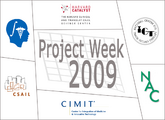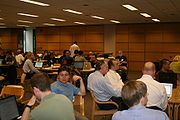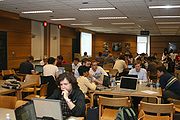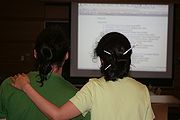Difference between revisions of "2009 Summer Project Week"
Medcomparts (talk | contribs) |
Medcomparts (talk | contribs) |
||
| Line 169: | Line 169: | ||
==Background== | ==Background== | ||
| − | From June 22 through 26, 2009, NA-MIC hosted its FIRST JOINT PROJECT WEEK for hands-on research and development activity in Image-Guided Therapy and Neuroscience applications. The meeting was held at MIT (Cambridge) and at the Brigham and Women's Hospital (Boston). Participants engaged in open source programming using the [[NA-MIC-Kit|NA-MIC Kit]], algorithms, medical imaging sequence development, tracking experiments, and clinical applications. The main goal of this event was to further the translational research deliverables of the sponsoring centers and their collaborators by identifying and solving programming problems during planned and ad hoc break-out sessions. Active and potential collaborators alike were encouraged to attend, and participants haled from 31 academic centers and 9 companies. The latest in a series of successful Project Events designed to maximize informal interaction between participants, this event was distinguished by the joint participation of several collaborating centers | + | From June 22 through 26, 2009, NA-MIC hosted its FIRST JOINT PROJECT WEEK for hands-on research and development activity in Image-Guided Therapy and Neuroscience applications. The meeting was held at MIT (Cambridge) and at the Brigham and Women's Hospital (Boston). Participants engaged in open source programming using the [[NA-MIC-Kit|NA-MIC Kit]], algorithms, medical imaging sequence development, tracking experiments, and clinical applications. The main goal of this event was to further the translational research deliverables of the sponsoring centers and their collaborators by identifying and solving programming problems during planned and ad hoc break-out sessions. Active and potential collaborators alike were encouraged to attend, and participants haled from 31 academic centers and 9 companies. The latest in a series of successful Project Events designed to maximize informal interaction between participants, this event was distinguished by the joint participation of several collaborating centers. This event is part of the ongoing translational research efforts of [http://www.na-mic.org NA-MIC], [http://www.ncigt.org NCIGT], [http://nac.spl.harvard.edu/NAC], [http://catalyst.harvard.edu/home.html Harvard Catalyst], and [http://www.cimit.org CIMIT]. It represents an expansion of the NA-MIC Summer Project Week that has been held annually since 2005. It will continue to be held every Summer at MIT and Brigham and Women's Hospital in Boston, typically during the last full week of June, and every Winter in Salt Lake City, Utah, typically during the second week of January. |
Active preparation for this conference began with a kick-off teleconference. Invitations to this call were sent to members of the sponsoring communities, their collaborators, past attendees of the event, as well as any parties expressing an interest in working with these centers. The main goal of the initial teleconference was to gather information about which groups/projects would be active at the upcoming event to ensure that there were sufficient resources available to meet everyone's needs. Focused discussions about individual projects were conducted during several subsequent teleconferences and permitted the hosts to finalize the project teams, consolidate any common components, and identify topics that should be discussed in break-out sessions. In the final days leading up to the meeting, all project teams were asked to complete a template page on the wiki describing the objectives and research plan for each project. All told, there were 135 registrants and 62 individual projects. | Active preparation for this conference began with a kick-off teleconference. Invitations to this call were sent to members of the sponsoring communities, their collaborators, past attendees of the event, as well as any parties expressing an interest in working with these centers. The main goal of the initial teleconference was to gather information about which groups/projects would be active at the upcoming event to ensure that there were sufficient resources available to meet everyone's needs. Focused discussions about individual projects were conducted during several subsequent teleconferences and permitted the hosts to finalize the project teams, consolidate any common components, and identify topics that should be discussed in break-out sessions. In the final days leading up to the meeting, all project teams were asked to complete a template page on the wiki describing the objectives and research plan for each project. All told, there were 135 registrants and 62 individual projects. | ||
Revision as of 14:48, 23 July 2009
Home < 2009 Summer Project Week
Back to Project Events, Events
Summary: The FIRST JOINT PROJECT WEEK (and the ninth NA-MIC Project Event) was held June 22-26, 2009 in Boston, at MIT and Brigham and Women's Hospital. It recorded 134 registered attendees, who worked on 62 projects. These attendees represented 31 academic sites and 9 companies. The projects, agenda, and affiliations of attendees are detailed below.
More pictures (taken by Junichi Tokuda).
Projects
Segmentation
- Lupus Lesion Segmentation (Mark Scully MRN)
- White Matter Lesion segmentation (Minjeong Kim UNC)
- Skull Stripping (Snehashis Roy JHU)
- EM Segment (Sylvain Jaume MIT, Nicolas Rannou BWH)
- FastMarching for brain tumor segmentation (Andrey Fedorov BWH)
- New Level Set Framework in ITK (Arnaud Gelas, Harvard Medical School)
- Tubular Surface Segmentation in Slicer (Vandana Mohan, Georgia Tech)
- The Vascular Modeling Toolkit in 3D Slicer (Daniel Haehn BWH)
- Cortical Thickness Pipeline (Clement Vachet UNC)
- Automatic brain MRI processing pipeline (Marcel Prastawa Utah)
- Segmentation of Knee Structures (Harish Doddi Stanford)
Registration
- Spherical Mesh Diffeomorphic Demons Registration (Luis Ibanez Kitware)
- BSpline Registration in Slicer3 (Samuel Gerber Utah)
- Registration reproducibility in Slicer3 (Andrey Fedorov BWH)
- Prostate Registration Slicer Module (Yi Gao, Georgia Tech)
- Slicer 3 registration (Andrew Rausch BWH PNL)
- EPI Correction in Slicer3 (Ran Tao Utah)
- 2d/3d Registration (and GPGPU acceleration) for Radiation Therapy (Tina Kapur BWH)
- Measuring Alcohol Stress Interaction (Vidya Rajgopalan Virginia Tech)
- Atlas to CT Registration in Trigeminal Neuralgia (Marta Peroni PoliMI)
- HAMMER Registration (Guorong Wu UNC)
- Cardiac Blood Pool Registration (Michal Depa MIT)
IGT
- Transrectal Prostate Biopsy (Andras Lasso Queen's)
- Prostate Robotics (Junichi Tokuda BWH)
- Liver Ablation in Slicer (Ziv Yaniv Georgetown)
- Demo of Neuronavigation using Brainlab, Slicer3, BioImage Suite (Haiying Liu BWH)
- 3D GRASE (Scott Hoge BWH)
- Using RTHawk to Implement MR Navigation (Ben Schwartz BWH)
- Integration of Flexible Surgical Instrument Modeling and Virtual Catheter with Slicer (Jayender Jagadeesan BWH)
- Integration of stereo video into Slicer3 (Mehdi Esteghamatian Robarts Institute)
- Enhanced Neurosuregery navigation (Haytham Elhawary, Brigham and Women's Hospital)
- GPU accelerated FEM for simulation and segmentation (Megumi Nakao, Brigham and Women's Hospital)
- Liver EM segmentation (Padma Akella, Brigham and Women's Hospital)
Radiotherapy
- DicomRT (Greg Sharp)
- Adaptive Radiotherapy for Head,Neck, and Thorax (Ivan Kolesov GATech)
- 2009_Summer_Project_Week_Cone_Beam_backprojection(James Balter U Michigan)
- 2009_Summer_project_week_3d_Deformable_alignment(Dan McShan U Michigan)
- 2009_Summer_project_week_adaptive_radiation_planning_visualization(Cal Hisley, Des Moines University/Mercy Des Moines Medical Center)
Analysis
- Meningioma growth simulation (Andrey Fedorov BWH)
- Linking atlas data with ontologies of brain morphology and function (Michael Halle BWH)
- MRSI Module (Bjoern Menze MIT)
- 4D Imaging (Perfusion, Cardiac, etc.) (Junichi Tokuda BWH)
- Gated 4D ultrasound reconstruction for Slicer3 (Danielle Pace Robarts Institute)
- multi-modality statistical toolbox for MR T1, T2, fMRI, DTI data (Diego Cantor Robarts Institute)
- Photograph Project (Junichi Tokuda, BWH)
Informatics
- XNAT user interface improvements for NA-MIC (Dan Marcus WUSTL)
- XNAT File System with FUSE (Dan Marcus WUSTL)
- GWE-XNAT Integration (Marco Ruiz UCSD)
- GWE Results Browser Improvements (Marco Ruiz UCSD)
- XNAT & Ortho App (Beatriz Paniagua UNC)
Diffusion
- Stochastic Tractography to study VCFS and Schizophrenia (Sylvain Bouix BWH)
- Functional Analysis of White Matter in Whole Brain Clustering of Schizophrenic Patients (Doug Terry BWH)
- Slicer module for the computation of fibre dispersion and curving measures (Peter Savadjiev BWH)
- DWI/DTI QC and Preparation Tool: DTIPrep (Zhexing Liu UNC)
- DTI digital phantom generator to create validation data sets - webservice/cmdlin module/binaries are downloadable from UCLA (Nathan Hageman UCLA)
- Fluid mechanics tractography and visualization (Nathan Hageman UCLA)
- Developing interactive stochastic tractography using CUDA (Julien de Siebenthal BWH)
Python
- Using ITK in python (Steve Pieper BWH)
- Accelerating python with cython: application to stochastic tractography (Julien de Siebenthal BWH)
- Taking advantage of multicore machines & clusters with python (Julien de Siebenthal BWH)
- Deferring heavy computational tasks with Slicer python (Julien de Siebenthal BWH)
Slicer Internals
- VTK 3d Widgets in Slicer3 (Nicole Aucoin BWH)
- Updates to Slicer3 Colors module (Nicole Aucoin BWH)
- Orthogonal Planes in Reformat Widget (Michal Depa MIT)
- Slicer3 Flexible Layouts (Wendy Plesniak BWH)
- Slicer3 Extension Manager (Katie Hayes BWH)
- IAFE Mesh Modules - improvements and testing (Curt Lisle Knowledge Vis)
Execution Model
- Plug-in 3D Viewer based on XIP (Lining Yang Siemens Research)
- Extension of the Command Line XML Syntax/Interface (Bennett Landman)
Agenda
Breakout Rooms: 32-D451, 38-413
Monday
- noon-1pm lunch
- 1pm: Welcome (Ron Kikinis)
- 1:05-3:30pm Introduce Projects using templated wiki pages (all Project Leads) (Wiki Template)
- 3:30-5:30pm Start project work
Tuesday
- 8:30am breakfast
- 8:30am-9:30am 4D Imaging Meeting
- 9:30-10am: NA-MIC Kit Overview (Jim Miller)
- 10-10:30am Slicer 3.4 Update (Steve Pieper) (Slides, Project Page)
- 10:30-11am Slicer IGT and Imaging Kit Update Update (Noby Hata Slides, Scott Hoge [ slides ])
- noon lunch
- 1pm Breakout Session: 2009 Project Week Breakout Session: Slicer-Python (Demian W) (Star D463 Star Conference Room in Stata)
- 2:00pm-3.00pm: Data Clinic (Ron Kikinis) (In Grier)
- 4:00pm: GWE End-To-End Live Demo (Marco Ruiz)
- 4:30pm CIMIT Forum (At BWH / Carl J. and Ruth Shapiro Cardiovascular Center) Open Source Software for Translational IGT Research and Commercial Use, Clif Burdette, Acoustic MedSystems, Inc.
- 5:30pm adjourn for day
Wednesday
- 8:30am breakfast
- 9am-12pm Breakout Session: 2009 Project Week Breakout Session: ITK (32-G451) (Luis Ibanez)
- 10am - 11am 32-D451 taken by Megason Lab.
- noon lunch
- 2:30pm: Breakout Session: 2009 Project Week Breakout Session: 3D+T Microscopy Cell Dataset Segmentation (D463 Star conference room) (Alexandre Gouaillard, Arnaud Gelas, Lydie Souhait, Badri Roysam, Curtis Rueden)
- 5:30pm adjourn for day
Thursday
- 8:30am breakfast
- 10-11am Tutorial Contest Presentations
- 11am: Breakout Session: Linking atlases, labels, and ontologies
- noon lunch
- 1:00pm: Breakout Session: 2009 Project Week Breakout Session: XNAT for Programmers (32-D451) (Dan M.)
- 5:30pm adjourn for day
Friday
- 8:30am breakfast
- 10am-noon: Tutorial Contest Winner Announcement and Project Progress Updates
- Noon: Lunch boxes and adjourn by 1:30pm.
- We need to empty room by 1:30. You are welcome to use wireless in Stata.
- Please sign up for the developer mailing lists
- Next Project Week in Utah, January 4-8, 2010
Background
From June 22 through 26, 2009, NA-MIC hosted its FIRST JOINT PROJECT WEEK for hands-on research and development activity in Image-Guided Therapy and Neuroscience applications. The meeting was held at MIT (Cambridge) and at the Brigham and Women's Hospital (Boston). Participants engaged in open source programming using the NA-MIC Kit, algorithms, medical imaging sequence development, tracking experiments, and clinical applications. The main goal of this event was to further the translational research deliverables of the sponsoring centers and their collaborators by identifying and solving programming problems during planned and ad hoc break-out sessions. Active and potential collaborators alike were encouraged to attend, and participants haled from 31 academic centers and 9 companies. The latest in a series of successful Project Events designed to maximize informal interaction between participants, this event was distinguished by the joint participation of several collaborating centers. This event is part of the ongoing translational research efforts of NA-MIC, NCIGT, [1], Harvard Catalyst, and CIMIT. It represents an expansion of the NA-MIC Summer Project Week that has been held annually since 2005. It will continue to be held every Summer at MIT and Brigham and Women's Hospital in Boston, typically during the last full week of June, and every Winter in Salt Lake City, Utah, typically during the second week of January.
Active preparation for this conference began with a kick-off teleconference. Invitations to this call were sent to members of the sponsoring communities, their collaborators, past attendees of the event, as well as any parties expressing an interest in working with these centers. The main goal of the initial teleconference was to gather information about which groups/projects would be active at the upcoming event to ensure that there were sufficient resources available to meet everyone's needs. Focused discussions about individual projects were conducted during several subsequent teleconferences and permitted the hosts to finalize the project teams, consolidate any common components, and identify topics that should be discussed in break-out sessions. In the final days leading up to the meeting, all project teams were asked to complete a template page on the wiki describing the objectives and research plan for each project. All told, there were 135 registrants and 62 individual projects.
On the first day of the conference, each project team leader delivered a short presentation to introduce their topic and individual members of their team. These brief presentations served to both familiarize other teams doing similar work about common problems or practical solutions, and to identify potential subsets of individuals who might benefit from collaborative work. For the remainder of the conference, about 50% time was devoted to break-out discussions on topics of common interest to particular subsets and 50% to hands-on project work. For hands-on project work, attendees were organized into 30-50 small teams comprised of 2-4 individuals with a mix of multi-disciplinary expertise. To facilitate this work, a large room at MIT was setup with ample work tables, internet connection, and power access. This enabled each computer software development-based team to gather on a table with their individual laptops, connect to the internet, download their software and data, and work on specific projects. Projects that required the use of medical devices were hosted at the Brigham and Women's Hospital. On the final day of the event, each project team summarized their accomplishments in a closing presentation.
A summary of all past NA-MIC Project Events is available here.
Preparation
- Please make sure that you are on the http://public.kitware.com/cgi-bin/mailman/listinfo/na-mic-project-week mailing list
- Join the kickoff TCON on April 16, 3pm ET.
- June 18 TCON at 3pm ET to tie loose ends. Anyone with un-addressed questions should call.
- By 3pm ET on June 11, 2009: Complete a templated wiki page for your project. Please do not edit the template page itself, but create a new page for your project and cut-and-paste the text from this template page. If you have questions, please send an email to tkapur at bwh.harvard.edu.
- By 3pm on June 18, 2009: Create a directory for each project on the NAMIC Sandbox (Zack)
- Commit on each sandbox directory the code examples/snippets that represent our first guesses of appropriate methods. (Luis and Steve will help with this, as needed)
- Gather test images in any of the Data sharing resources we have (e.g. the BIRN). These ones don't have to be many. At least three different cases, so we can get an idea of the modality-specific characteristics of these images. Put the IDs of these data sets on the wiki page. (the participants must do this.)
- Setup nightly tests on a separate Dashboard, where we will run the methods that we are experimenting with. The test should post result images and computation time. (Zack)
- Please note that by the time we get to the project event, we should be trying to close off a project milestone rather than starting to work on one...
- People doing Slicer related projects should come to project week with slicer built on your laptop.
- Projects to develop extension modules should work with the Slicer-3-4 branch (new code should not be checked into the branch).
- Projects to modify core behavior of slicer should be done on the trunk.
Logistics
- Dates: June 22-26, 2009
- Location: MIT. Grier Rooms A & B: 34-401A & 34-401B.
- 32-D451 (Stata)
- Mon, noon - end
- Tues, Wed, Thurs, all day
- 38-413 (Lg Conference room inside EECS Headquarters)
- Mon, noon-end
- Tues, Wed, Thurs, 9-end
- Fri, 9-1:00
- Registration Fee: $260 (covers the cost of breakfast, lunch and coffee breaks for the week). Due by Friday, June 12th, 2009. Please make checks out to "Massachusetts Institute of Technology" and mail to: Donna Kaufman, MIT, 77 Massachusetts Ave., 38-409a, Cambridge, MA 02139. Receipts will be provided by email as checks are received. Please send questions to dkauf at mit.edu. If this is your first event and you are attending for only one day, the registration fee is waived. Please let us know, so that we can cover the costs with one of our grants.
- Registration Method Add your name to the Attendee List section of this page
- Hotel: We have a group rate of $189/night (plus tax) at the Le Meridien (which used to be the Hotel at MIT). Please click here to reserve. This rate is good only through June 1.
- Here is some information about several other Boston area hotels that are convenient to NA-MIC events: Boston_Hotels. Summer is tourist season in Boston, so please book your rooms early.
- 2009 Summer Project Week Template
- Last Year's Projects as a reference
- For hosting projects, we are planning to make use of the NITRC resources. See Information about NITRC Collaboration
Attendee List
Please do not add any more names here. If you need to register, please send an email to tkapur at bwh.harvard.edu and we will accommodate you if we can.
|
|
Please do not add any more names here. If you need to register, please send an email to tkapur at bwh.harvard.edu and we will accommodate you if we can.
The following was used to convert from excel to mediawiki markup: http://area23.brightbyte.de/csv2wp.php





